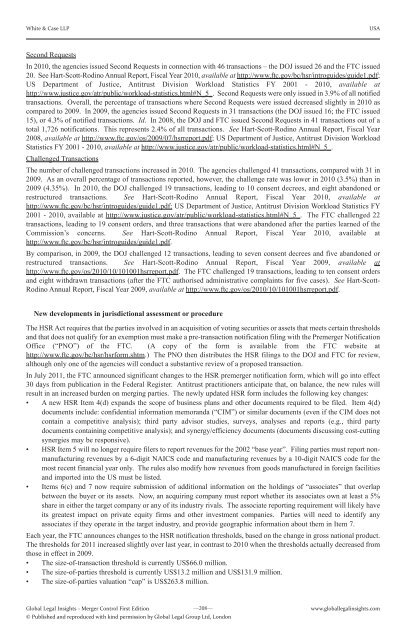Merger Controls First Edition - J Sagar Associates
Merger Controls First Edition - J Sagar Associates
Merger Controls First Edition - J Sagar Associates
You also want an ePaper? Increase the reach of your titles
YUMPU automatically turns print PDFs into web optimized ePapers that Google loves.
White & Case LLP USA<br />
Second Requests<br />
In 2010, the agencies issued Second Requests in connection with 46 transactions – the DOJ issued 26 and the FTC issued<br />
20. See Hart-Scott-Rodino Annual Report, Fiscal Year 2010, available at http://www.ftc.gov/bc/hsr/introguides/guide1.pdf;<br />
US Department of Justice, Antitrust Division Workload Statistics FY 2001 - 2010, available at<br />
http://www.justice.gov/atr/public/workload-statistics.html#N_5_. Second Requests were only issued in 3.9% of all notified<br />
transactions. Overall, the percentage of transactions where Second Requests were issued decreased slightly in 2010 as<br />
compared to 2009. In 2009, the agencies issued Second Requests in 31 transactions (the DOJ issued 16; the FTC issued<br />
15), or 4.3% of notified transactions. Id. In 2008, the DOJ and FTC issued Second Requests in 41 transactions out of a<br />
total 1,726 notifications. This represents 2.4% of all transactions. See Hart-Scott-Rodino Annual Report, Fiscal Year<br />
2008, available at http://www.ftc.gov/os/2009/07/hsrreport.pdf; US Department of Justice, Antitrust Division Workload<br />
Statistics FY 2001 - 2010, available at http://www.justice.gov/atr/public/workload-statistics.html#N_5_.<br />
Challenged Transactions<br />
The number of challenged transactions increased in 2010. The agencies challenged 41 transactions, compared with 31 in<br />
2009. As an overall percentage of transactions reported, however, the challenge rate was lower in 2010 (3.5%) than in<br />
2009 (4.35%). In 2010, the DOJ challenged 19 transactions, leading to 10 consent decrees, and eight abandoned or<br />
restructured transactions. See Hart-Scott-Rodino Annual Report, Fiscal Year 2010, available at<br />
http://www.ftc.gov/bc/hsr/introguides/guide1.pdf; US Department of Justice, Antitrust Division Workload Statistics FY<br />
2001 - 2010, available at http://www.justice.gov/atr/public/workload-statistics.html#N_5_. The FTC challenged 22<br />
transactions, leading to 19 consent orders, and three transactions that were abandoned after the parties learned of the<br />
Commission’s concerns. See Hart-Scott-Rodino Annual Report, Fiscal Year 2010, available at<br />
http://www.ftc.gov/bc/hsr/introguides/guide1.pdf.<br />
By comparison, in 2009, the DOJ challenged 12 transactions, leading to seven consent decrees and five abandoned or<br />
restructured transactions. See Hart-Scott-Rodino Annual Report, Fiscal Year 2009, available at<br />
http://www.ftc.gov/os/2010/10/101001hsrreport.pdf. The FTC challenged 19 transactions, leading to ten consent orders<br />
and eight withdrawn transactions (after the FTC authorised administrative complaints for five cases). See Hart-Scott-<br />
Rodino Annual Report, Fiscal Year 2009, available at http://www.ftc.gov/os/2010/10/101001hsrreport.pdf.<br />
New developments in jurisdictional assessment or procedure<br />
The HSR Act requires that the parties involved in an acquisition of voting securities or assets that meets certain thresholds<br />
and that does not qualify for an exemption must make a pre-transaction notification filing with the Premerger Notification<br />
Office (“PNO”) of the FTC. (A copy of the form is available from the FTC website at<br />
http://www.ftc.gov/bc/hsr/hsrform.shtm.) The PNO then distributes the HSR filings to the DOJ and FTC for review,<br />
although only one of the agencies will conduct a substantive review of a proposed transaction.<br />
In July 2011, the FTC announced significant changes to the HSR premerger notification form, which will go into effect<br />
30 days from publication in the Federal Register. Antitrust practitioners anticipate that, on balance, the new rules will<br />
result in an increased burden on merging parties. The newly updated HSR form includes the following key changes:<br />
• A new HSR Item 4(d) expands the scope of business plans and other documents required to be filed. Item 4(d)<br />
documents include: confidential information memoranda (“CIM”) or similar documents (even if the CIM does not<br />
contain a competitive analysis); third party advisor studies, surveys, analyses and reports (e.g., third party<br />
documents containing competitive analysis); and synergy/efficiency documents (documents discussing cost-cutting<br />
synergies may be responsive).<br />
• HSR Item 5 will no longer require filers to report revenues for the 2002 “base year”. Filing parties must report nonmanufacturing<br />
revenues by a 6-digit NAICS code and manufacturing revenues by a 10-digit NAICS code for the<br />
most recent financial year only. The rules also modify how revenues from goods manufactured in foreign facilities<br />
and imported into the US must be listed.<br />
• Items 6(c) and 7 now require submission of additional information on the holdings of “associates” that overlap<br />
between the buyer or its assets. Now, an acquiring company must report whether its associates own at least a 5%<br />
share in either the target company or any of its industry rivals. The associate reporting requirement will likely have<br />
its greatest impact on private equity firms and other investment companies. Parties will need to identify any<br />
associates if they operate in the target industry, and provide geographic information about them in Item 7.<br />
Each year, the FTC announces changes to the HSR notification thresholds, based on the change in gross national product.<br />
The thresholds for 2011 increased slightly over last year, in contrast to 2010 when the thresholds actually decreased from<br />
those in effect in 2009.<br />
• The size-of-transaction threshold is currently US$66.0 million.<br />
• The size-of-parties threshold is currently US$13.2 million and US$131.9 million.<br />
• The size-of-parties valuation “cap” is US$263.8 million.<br />
Global Legal Insights <strong>Merger</strong> Control <strong>First</strong> <strong>Edition</strong><br />
—208—<br />
© Published and reproduced with kind permission by Global Legal Group Ltd, London<br />
www.globallegalinsights.com


